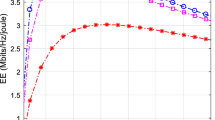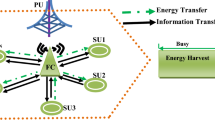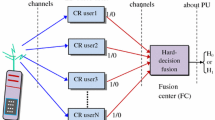Abstract
In order to address the issue of spectrum scarcity, cognitive radio (CR) offers an effective usage of radio spectrum resources by offering dynamic spectrum access. One kind of wireless sensor networks having CR capabilities are wireless cognitive radio sensor networks (WCRSNs). The present work investigates throughput and energy-efficiency of WCRSN. More precisely, scenarios involving both noise and \(\alpha -\mu\) fading that affect the sensing (S) channels are taken into consideration. Each cognitive radio sensor (CRS) receives an unknown licensed signal information from the primary user (PU). The CRS uses an energy detection sensing technique and makes a local decision in one-bit binary form. The decisions from all the CRSs are forwarded to control center via reporting (R) channels and are combined based on the hard-decision fusion technique for making the final decision about active and inactive status of the PU. Throughput and energy-efficiency performances of WCRSN are assessed while taking into account the effects of pertinent network factors. To that end, first a brand-new mathematical probability of detection that is subject to noise plus generalized \(\alpha -\mu\) fading is established. Additionally, a computer based simulation and experimental setup are performed to verify the resulting expression. The analytical frameworks for assessing throughput and energy-efficiency performances under a variety of network and channel situations are then developed. Further, the effect of inaccurate S and R channels with channel error probability (q) on the general effectiveness of WCRSN is also examined. Finally, the effects of the \(\alpha -\mu\) fading parameters, the signal-to-noise ratio, the number of CRSs, and the detection threshold on the WCRSN are examined. For a number of network characteristics, throughput is maximized and energy-efficiency is up to 75% has been achieved.











Similar content being viewed by others
Data availability
The data that support the findings of this study are available from the corresponding author upon reasonable request.
References
Ghasemi, A., & Sousa, E. S. (2007). Opportunistic spectrum access in fading channels through collaborative sensing? IEEE Transactions on Wireless Communications, 2(2), 71–82.
Biglieri, E. (2012). An overview of cognitive radio for satellite communications. In Proceedings of IEEE First AESS European conference on satellite telecommunications (ESTEL) (pp. 1–3).
Bhandari, S., & Joshi, S. (2018). Cognitive radio technology in 5G wireless communications. In Proceedings of IEEE international conference on power electronics, intelligent control and energy systems (ICPEICES) (pp. 1–6).
Urkowitz, H. (1967). Energy detection of unknown deterministic signals. Proceedings of IEEE, 55(4), 523–231.
Digham, F. F., Alouini, M.-S., & Simon, M. K. (2007). On the energy detection of unknown signals over fading channels. IEEE Transactions on Communications, 55(1), 21–24.
Duan, J., & Li, Y. (2010). Performance analysis of cooperative spectrum sensing in different fading channels. In Proceedings of IEEE interantional conference on computer engineering and technology (ICCET) (pp. 64–68).
El-Saleh Ayman, A., Ismail, M., Mahamod, M. A., Mohd Ali, M., Kamarudin, R., & Rahman, T. A. (2011). Analytical simulation and performance optimization for spectrum sensing in cognitive radio networks. International Journal on Computer Science and Engineering (IJCSE), 3(2), 554–568.
Chaudhari, S., Lundn, J., Koivunen, V., & Vincent Poor, H. (2012). Cooperative sensing with imperfect reporting channels: Hard decisions or soft decisions? IEEE Transactions on Sgnal Processing, 60(1), 18–28.
Ferrari, G., & Pagliari, R. (2006). Decentralized detection in sensor networks with noisy communication links. In F. Davoli, S. Zappetore, & S. Pelezzo (Eds.), Distibuted cooperative laboratories: Networking, instrumentation, and measurements (pp. 233–249). Springer.
Chen, B., Jiang, R., Kasetkasem, T., & Varshney, P. (2004). Channel aware decision fusion in wireless sensor networks. IEEE Transactions on Signal Processing, 52, 3454–3458.
Rago, C., Willett, P., & Bar-Shalom, Y. (1996). Censoring sensors: A low-communication-rate scheme for distributed detection. IEEE Transcations on Aerospace and Electronic System, 17, 554–567.
Appadwedula, S., Veeravalli, V. V., & Jones, D. L. (2005). Energy-efficient detection in sensor networks. IEEE Journal on Selected Areas in Communications, 23(4), 693–702.
Ahmadi, H. R., & Vosoughi, A. (2009). Channel aware sensor selection in distributed detection systems. In Proceedings of IEEE 10th workshop on volume signal processing advances in wireless communications (SPAWC) (pp. 71–75).
Nallagonda, S., Chandra, A., Roy, S. D., Kundu, S., Kukolev, P., & Prokes, A. (2016). Detection performance of cooperative spectrum sensing with hard decision fusion in fading channels. International Journal of Electronics (Taylor & Francis), 103(2), 297–321.
Ranjeeth, M., Anuradha, S., & Nallagonda, S. (2020). Optimized cooperative spectrum sensing network analysis in nonfading and fading environments. International Journal of Communication Systems, 33(5), e42-62.
Banavathu, N. R., & Khan, M. Z. A. (2016). On the throughput maximization of cognitive radio using cooperative spectrum sensing over erroneous control channel. In Proceedings of IEEE national conference on communication (NCC) (pp. 1–6). IIT Guwahati.
Balam, S. K., Siddaiah, P., & Nallagonda, S. (2021). Optimization analysis of cooperative spectrum sensing system over generalized \(\kappa -\mu\) and \(\eta -\mu\) fading channels, Wireless Personal Communications (WPC). Springer, 116(4), 3081–3100.
Nallagonda, S., Bhowmick, A., & Prasad, B. (2022). On selection of parameters for cooperative spectrum sensing schemes over \(\kappa -\mu\) fading channels. IETE Journal of Research (IETE). https://doi.org/10.1080/03772063.2022.2038700
Balam, S. K., Siddaiah, P., & Nallagonda, S. (2019). Throughput analysis of cooperative cognitive radio network over generalized \(\kappa -\mu\) and \(\eta -\mu\) fading channels. Wireless Networks (WINE), 25(8), 4625–4638.
Nallagonda, S., Kiran Kumar, G., & Nallagonda, A. K. (2018). Throughput and energy efficiency of cooperative cognitive radio network over erroneous generalized fading channel. In Proceedings of IEEE India council international conference (INDICON) (pp. 1–5).
Alnwaimi, G., & Boujemaa, H. (2019). Throughput analysis and optimization of cognitive radio networks using incremental relaying. IEEE Tranactions on Vehcular Technology, 71(8), 231–247.
Miah, M. S., Schukat, M., & Barrett, E. (2020). Sensing and throughput analysis of a MU-MIMO based cognitive radio scheme for the Internet of Things. Computer Communications, 154, 442–454.
Yacoub, M. D. (2002). The \(\alpha -\mu\) distribution: A general fading distribution. In Proceedings of IEEE international symposium on personal indoor and mobile radio communications (PIMRC) (pp. 1–5).
Yacoub, M. D. (2007). The \(\alpha -\mu\) distribution: A physical fading model for the stacy distribution. IEEE Tranactions on Vehcular Technology, 56(1), 27–34.
Zou, Y., Zhu, J., Yang, L., Liang, Y. C., & Yu-dong, Y. (2015). Securing physical-layer communications for cognitive radio networks. IEEE Communications Magazine, 53(9), 48–54.
Moualeu, J. M., Costa, D. B., Martinez, F. J. L., Hamouda, W., Ngatched, T. M. N., & Dias, U. S. (2019) Secrecy analysis of a TAS/MRC scheme in \(\alpha -\mu\) fading channels. In Proceedings of IEEE wireless communications and networking conference (WCNC) (pp. 1–6).
Singh, P., & Soni, S. K. (2022). Analytical framework for the performance of energy detectors over \(\alpha -\mu\) fading model with MRC diversity. International Journal of Communication Systems, 35(4), e50–e38.
Nallagonda, S., Lakshmi Prathyusha, O., & Ranjeeth, M. (2022). Performance of generalized \(\alpha -\mu\) fading for energy detection based spectrum sensing in presence of channel errors. In Proceedings of IEEE 8th international conference on advanced computing and communication systems (ICACCS) (pp. 1–6).
Talukdar, B., Kumar, D., Kundu, A., & Arif, W. (2020). Performance analysis of an EH-CRN under \(\alpha -\mu\) fading scenario. In Proceedings of IEEE advanced communication technologies and signal processing (ACTS) (pp. 1–5).
Jayashree, A., & Neema, J. (2016). A framework to integrate cognitive radio sensing with wireless sensor network. In Proceedings of IEEE international conference on wireless and optical communications networks (WOCN) (pp. 1–5).
Ozger, M., Pehlivanoglu, E. B., & Akan, O. B. (2022). Energy-efficient transmission range and duration for cognitive radio sensor networks. IEEE Transactions on Cognitive Communications and Networking, 8(2), 907–918.
Chougule, R. A., & Rajani, H. P. (2021).Energy efficiency analysis in spectrum sensing cognitive radio network. In Proceedings of IEEE international conference on intelligent technologies (CONIT) (pp. 1–5).
Santhoshkumar, M., & Premkumar, K. (2021). Energy-throughput tradeoff with optimal sensing order in cognitive radio networks. In Proceedings of IEEE international conference on communication systems & networks (COMSNETS) (pp. 1–5).
Ma, M., Li, Z., Lin, Y., Chen, L., & Wang, S. (2020) Modulation classification method based on deep learning under non-Gaussian noise. In Proceedings of 91st IEEE vehicular technology conference (VTC2020-Spring) (pp. 1–5).
Nuttall, A. H. (1975). Some integrals involving the QM function. IEEE Transactions on Information Theory, 21(1), 95–96.
Gradshteyn, I. S., & Ryzhik, I. M. (2007). Table of Integrals, Series and Products (7th ed.). Elsevier.
Banavathu, N. R., & Khan, M. Z. A. (2017). Optimal number of cognitive users in \(K\)-out-of-\(M\) rule. IEEE Wireless Communications Letters, 6(5), 606–609.
Hu, H., Zhang, H., Yu, H., Chen, Y., & Jafarian, J. (2015). Energy-efficient design of channel sensing in cognitive radio networks. Computers and Electrical Engineering, 42, 207–220.
Funding
This work was supported by Science and Engineering Research Board (SERB) under the Ministry of the Department of Science and Technology (DST), Government of India, SERB Grant Number is EEQ/2021/000190.
Author information
Authors and Affiliations
Corresponding author
Ethics declarations
Conflict of interest
Author declares that he has no conflict of interest.
Ethical approval
This article does not contain any studies with human participants or animals performed by any of the authors.
Additional information
Publisher's Note
Springer Nature remains neutral with regard to jurisdictional claims in published maps and institutional affiliations.
Rights and permissions
Springer Nature or its licensor (e.g. a society or other partner) holds exclusive rights to this article under a publishing agreement with the author(s) or other rightsholder(s); author self-archiving of the accepted manuscript version of this article is solely governed by the terms of such publishing agreement and applicable law.
About this article
Cite this article
Nallagonda, S. Energy-efficiency performance of wireless cognitive radio sensor network with hard-decision fusion over generalized \(\alpha -\mu\) fading channels. Wireless Netw 29, 2759–2771 (2023). https://doi.org/10.1007/s11276-023-03350-4
Accepted:
Published:
Issue Date:
DOI: https://doi.org/10.1007/s11276-023-03350-4




